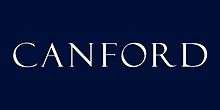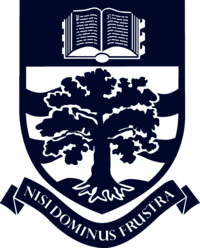Canford School
Canford School is a coeducational independent school for day and boarding pupils. Situated in 300 acres of parkland near to the market town of Wimborne Minster in Dorset, south west England, it is one of the largest schools by area.
| Canford School | |
|---|---|
 | |
| Address | |
, , BH21 3AD | |
| Information | |
| Type | Public school Independent school |
| Motto | Latin: Nisi Dominus Frustra Unless the Lord in Vain |
| Established | 1923 |
| Department for Education URN | 113922 Tables |
| Head Master | Ben Vessey |
| Staff | c. 100 |
| Gender | Co-educational |
| Age | 13 to 18 |
| Enrolment | 660 |
| Houses | 10 |
| Colour(s) | Blue & White |
| Publication | The Canfordian The Week |
| Alumni | Old Canfordians |
| Website | www |
The school is a member of the Headmasters' and Headmistresses' Conference.[1] Called a public school, Canford's fees are currently £12,686 per term for boarders.[2] The school is rated outstanding by Ofsted and is consistently ranked among the best co-educational independent schools nationally. In 2014, and again in 2016, Canford was among four runners-up for "Public School of the Year" in the Tatler School Awards and received the top award in 2019.[3][4]
The school has an enrolment of 660 students, the highest in its history, aged between 13 and 18 spread across seven boarding and three day houses. Canford School counts among its alumni high-ranking military officers, pioneers in industry, computing, and economics, as well as senior figures in the Arts and Sciences.
History

Canford Manor was particularly associated with John of Gaunt, 1st Duke of Lancaster - the third of five surviving sons of King Edward III of England. The Duke exercised great influence over the English throne during the minority of King Richard II's reign, and the ensuing periods of political strife. Due to some generous land grants, he was one of the richest, and most powerful, men of his era. John of Gaunt's legitimate male heirs, the Lancasters, include English kings Henry IV, Henry V, and Henry VI.[5]
Because of his rank, John of Gaunt was one of England's principal military commanders in the 1370s and 1380s, though his enterprises were never rewarded with the kind of dazzling success that had made his elder brother Edward the Black Prince such a charismatic war leader. On the resumption of war with France in 1369, John of Gaunt assumed the position of military commander in France. On his return from France in 1374, John took a more decisive and persistent role in the direction of English foreign policy. From then until 1377, he was effectively the head of the English government due to the illness of his father and elder brother, who were unable to exercise authority. His vast estates made him the richest man in England, and his great wealth, ostentatious display of it, autocratic manner and attitudes, enormous London mansion, and association with the failed peace process at Bruges combined to make him the most visible target of social resentments.[6]
Records suggest the Canford Manor was used as a principal residence of John of Gaunt for some time. Of that early period, only the Norman church and 14th century refectory known as John O' Gaunt's Kitchen remains. The main building, constituting the nucleus of the school, was designed by Edward Blore and later by Sir Charles Barry in the early and mid 1800s. The school itself was founded in 1923, having been "provided with a nucleus of boys and staff from a small private school in Weston-super-Mare".[7]
Assyrian frieze

In 1992, a lost Assyrian stone relief was rediscovered on the wall of "the Grubber".[8] Although it is at first sight rather unlikely that such a valuable item should be found on the wall of a school tuck shop, the history of the school explains how the relief came to be there. It had been brought back from the site of Nimrud in northern Mesopotamia (Iraq) by Sir Austen Henry Layard along with other antiquities which were displayed at Canford before it was a school. Originally Canford had been a private country house (known as Canford Manor), designed by Edward Blore and improved by Sir Charles Barry, and the residence of Layard's cousin and mother-in-law, Lady Charlotte Guest and her husband, Sir John Josiah Guest. At that time, the building now known as the Grubber had been used to display antiquities and was known as "the Nineveh Porch". It was however believed by the school authorities to be a plaster copy of an original which had been lost overboard during river transit and little attention was paid to it after the school was established. A dartboard was even hung in the Grubber close to where the frieze was displayed. It was John Russell of Columbia University who identified the frieze as an original, one of a set of three relief slabs taken from the throne room of Assyrian King Assurnasirpal II (883–859 BC). A new plaster copy now stands in the foyer of the Layard Theatre at Canford and a number of "Assyrian Scholarships" are available, funded from the sale proceeds which also helped pay for the construction of a new sports facility.[9]
The original relief is now part of the collection of the Miho Museum in Japan.[10][11]
The Layard Theatre
The Layard Theatre is situated inside Canford School and is open to the public.[12]
Old Canfordians
Former pupils of Canford School are known as Old Canfordians. Notable alumni include:
- The Very Reverend Henry Lloyd (1911–2001), Anglican priest, Dean of Truro[13]
- Stephen Ward (1912–1963), osteopath involved in the Profumo affair[13]
- Hector Maclean (1913–2007), decorated RAF officer during Battle of Britain[13]
- Sir George Clark, 3rd Baronet DL (1914–1991), Unionist politician in Northern Ireland[13]
- Sir Ralph Verney, 5th Baronet KBE, DL (1915-2001) British Army Officer and Politician[13]
- Sir Ashley Bramall (1916–1999), leader of the Inner London Education Authority, 1970–1981[13]
- Charles Maclean of Duart, Baron Maclean (1916–1990), Chief Scout of the United Kingdom, 1959–1971, Chief Scout of the Commonwealth, 1959–1975, and Lord Chamberlain, 1971–1984[13]
- Lieutenant Colonel Hilary Hook (1917–1990), Soldier and 'Home from the Hill' star[13]
- Ted Cooke-Yarborough (1918–2013) physicist and WW2 radar and computer pioneer[14][13]
- Paul Feiler (1918-2013), abstract artist[13]
- Mike Randall (1919–1999), editor of the Daily Mail and Sunday Times[13]
- David Sheldrick (1919–1977), Anglo-Kenyan conservationist[13]
- John Barnes (1920-2008), Historian[13]
- Peter Hare (1920–2001), cricketer[13]
- Rear Admiral John Templeton-Cotill (1920-2011), Naval Officer[13]
- Hector Monro, Baron Monro of Langholm (1922–2006), Conservative politician[13]
- Stuart Symington (1926–2009), cricketer[13]
- John Douglas, 21st Earl of Morton (1927–2016), Deputy Lieutenant of West Lothian[13]
- Michael Ash (1927), Mathematician, brewer, and inventor of the Easy Serve Draught Guinness[13]
- Iain Campbell (1928-2015), Cricketer[13]
- Michael Medwin (1923-2020), actor[13]
- Rutherford Aris (1929–2005), chemical engineer, Regents Professor Emeritus[13]
- David Littman (born 1933), historian and human rights advocate[13]
- Sir John Drummond (1934–2006), arts administrator, former controller of BBC Radio 3[13]
- General Sir Brian Kenny (1934-2017)[13]
- Second Lieutenant Paul Benner GC (1935–1957), awarded the George Cross[13]
- Stan Brock (1936), television presenter, philanthropist[13]
- Anthony Bryer OBE (1937-2016), Historian[13]
- Air Chief Marshal Sir Roger Palin (born 1938)[13]
- Simon Preston CBE (born 1938), organist, conductor, composer[13]
- Stephen Rubin OBE (born 1938), founder of Pentland Industries (Hunter, Speedo, Berghaus, Ellesse, etc.)[13]
- Derek Jarman (1942–1994), film director and gay rights activist[13]
- Ian Bradshaw (born 1940s), Photographer and winner of the World Press Photo Award[13]
- Sir Henry Cecil (1943–2013), champion race horse trainer[13]
- Admiral Sir Ian Garnett (born 1944), naval officer[13]
- Rear Admiral Sir Jeremy De Halpert KCVO, CB (born 1945), Naval Secretary[13]
- Tim Stevenson (born 1948), Lord Lieutenant[13]
- Simon Crowcroft (born 1950), Connétable of St Helier[13]
- David Docwra (born 1953), cricketer and educator[13]
- Alan Hollinghurst (born 1954), Booker Prize winning author[13]
- Peter Parker (born 1954), Author, Journalist, and Fellow of the Royal Society of Literature [13]
- Christopher Edward Berkeley Portman, 10th Viscount Portman (born 1958), British peer and property developer[13]
- Owen Bennett-Jones, journalist, 'Newshour'[13]
- Sir Philip Moor (born 1959), judge of the High Court of England and Wales[13]
- Nigel Robertson (born 1962), entrepreneur, founder of FreePages plc[13]
- Simon Hilton (born 1967), music video director[13]
- Nick Robertson OBE (born 1967), Co-founder and former CEO of ASOS[13]
- Tom Holland, (born 1968), novelist and popular historian[13]
- Major General Nicholas Borton DSO MBE (born 1969), General Officer Commanding 3rd Division[13]
- Stephen Phillips QC, MP (born 1970), Conservative politician[13]
- Giles Duley (born 1971), photojournalist[13]
- Miranda Cooper (born 1975), formerly the singer 'Moonbaby', songwriter and director of the company Xenomania[13]
- William Villiers, 10th Earl of Jersey (born 1976)[13]
- Yvonne Lui (born 1977), property magnate, philanthropist[13]
- Nicholas Ashley-Cooper, 12th Earl of Shaftesbury (born 1979)[13]
- Ben Gollings (born 1980), England rugby sevens player[13]
- Alex Hibbert (born 1986), polar explorer[13]
- Ore Oduba (born 1986), Presenter and sports journalist, 2016 Winner of Strictly Come Dancing[15][13]
- Brice Stratford (born 1987) Shakespearean Actor-manager[13]
- Chloe-Jasmine Whichello (born 1991) Reality TV star[13]
- Brianna Stubbs (born 1991), GB rower[13]
See also
- Bryanston School, Dorset
- Sherborne School, Dorset
References
- "HMC Schools Directory". HMC. Retrieved 19 February 2018.
- "Fees". Canford School. Retrieved 19 February 2018.
- "Tatler Schools Awards 2014 – the winners". Tatler. 2014. Retrieved 19 February 2018.
- "Tatler Schools Guide 2020". Tatler. 2016. Retrieved 19 February 2018.
- "Henry IV". English Monarchs. Retrieved 15 July 2018.
- Sumption (2009), pp. 325–327
- "Dorset Natural History and Archaeological Society, Volumes 94-99, 1973, Dorset Natural History and Archaeological Society, Archaeology". p. 153. Retrieved 11 March 2018.
- Russell, John Malcolm, ed. (1997). From Nineveh to New York: The strange story of the Assyrian reliefs in the Metropolitan Museum and the hidden masterpiece at Canford School. New Haven/London: Yale University Press; New York: The Metropolitan Museum of Art.
- "Assyrian Frieze | Canford School". Canford.com. Retrieved 18 February 2018.
- McKenzie, Judith (1997). "10". Canford School. Russell. pp. 173–189.
- Paley, Samuel M. (1999). "A winged genius and royal attendant from the Northwest Palace at Nimrud". Bulletin of the Miho Museum. 2: 17–29, Plate 1.
- "Layard Theatre". Ticket Source. Retrieved 15 July 2018.
- "Notable O.C.'s" The Old Canfordian Magazine. The Old Canfordian Society, Dorset. 2018.
- "Obituaries: Ted Cooke-Yarborough". The Daily Telegraph. London. 4 April 2013. Retrieved 5 April 2013.
- Barber, Marilyn (13 December 2016). "Strictly finalist Ore Oduba is a former pupil of Dumpton and Canford schools in Wimborne". Blackmore Vale. Retrieved 19 December 2016.
Sources
- Sumption, Jonathan (2009). The Hundred Years War: Divided houses. Volume III. Faber and Faber. ISBN 978-0571138975.
External links
- Canford School website
- Profile at the Good Schools Guide
- The Allied Schools